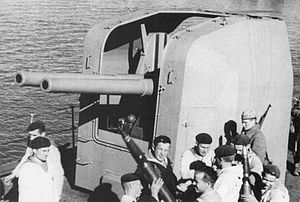Škoda 10 cm K10
| Škoda 10 cm K10 | |
|---|---|

A twin "Minizini" mount aboard the Soviet cruiser Krasnyi Kavkaz
|
|
| Type |
Naval gun Dual-purpose gun Coastal artillery Anti-aircraft gun |
| Place of origin | Austria-Hungary |
| Service history | |
| Used by | Austria-Hungary Italy France Spain Sweden Soviet Union |
| Wars |
World War I Spanish Civil War World War II |
| Production history | |
| Designer | Skoda |
| Designed | 1907 |
| Manufacturer | Skoda |
| Produced | 1910 |
| Variants | Škoda 10 cm K07 Škoda 10 cm K11 OTO 100/47 |
| Specifications | |
| Weight | 2,020 kilograms (4,450 lb) |
| Barrel length | 4.985 meters (16.35 ft) 50 caliber |
|
|
|
| Shell | Fixed QF ammunition |
| Shell weight | 13.75 kilograms (30.3 lb) |
| Caliber | 100 millimeters (3.9 in) |
| Breech | Horizontal sliding breech block |
| Elevation |
Austria-Hungary: -4° to +18° |
| Traverse | 360° |
| Rate of fire | 8-10 rpm |
| Muzzle velocity | 880 meters per second (2,900 ft/s) |
| Maximum firing range |
Austria-Hungary: 11 km (6.8 mi) at +14° |
Austria-Hungary: -4° to +18°
Italian: -5° to +85°
Austria-Hungary: 11 km (6.8 mi) at +14°
Italian: 15.2 km (9.4 mi)
at 45°
The Škoda 10 cm K10 was a light-calibre 100 mm (4-inch) naval gun of the Austro-Hungarian Navy used as tertiary armament on semi-dreadnought battleships and as primary armament on scout cruisers and destroyers during World War I. After World War I, variants of the Škoda 10 cm K10 were widely produced in Italy as the 100/47 series of guns, which served in a number of roles, on a wide variety of ships, with a number of navies.
The origins of the Škoda 10 cm K10 began with the earlier K07 developed in 1907 at the Škoda works in Pilsen. When the gun was put into production in 1910 it was renamed the Škoda 10 cm K10 and entered service aboard the Radetzky-class battleships in 20 single mount casemates amidships. The K11 model soon followed the K10 into service aboard the cruiser SMS Admiral Spaun, the Novara-class cruisers and the Tátra-class destroyers of the Austro-Hungarian Navy in low-angle, single gun turrets. The main difference between the various models was their mounts, traverse and elevation. After World War I SMS Radetzky, SMS Erzherzog Franz Ferdinand and SMS Zrínyi were ceded to Italy and scrapped between 1920 and 1926. SMS Admiral Spaun was ceded to the British and sold to an Italian company for scrapping in 1922. The Novara and Tatar classes proved ideal for service in the Adriatic during the First World War and the surviving units were ceded as war reparations to Italy and France. SMS Helgoland (renamed Brindisi) and SMS Saida (renamed Venezia) served in the Italian Navy until scrapped in 1937, while SMS Novara (renamed Thionville) served in the French Navy until scrapped in 1942. Three of the Tátra-class destroyers, Triglav II, Lika II, and Uzsok, were ceded to Italy as the Fasana class and Dukla was ceded to France. These ships were little used and re-rated as torpedo boats in 1929, with the last ships being scrapped in 1936. In 1937 the salvaged 10 cm K10's were landed and assigned to coastal artillery. At the outbreak of World War II, 41 guns were still in service.
...
Wikipedia
